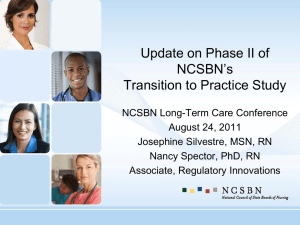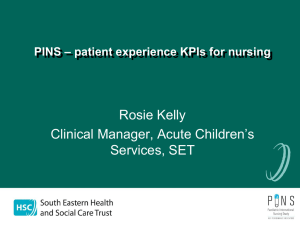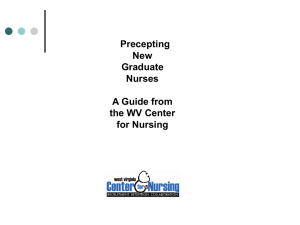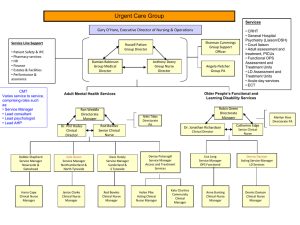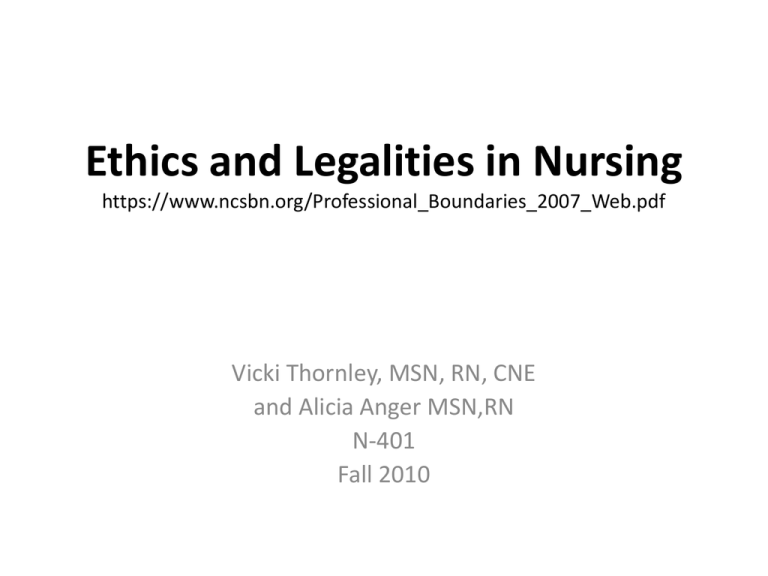
Ethics and Legalities in Nursing
https://www.ncsbn.org/Professional_Boundaries_2007_Web.pdf
Vicki Thornley, MSN, RN, CNE
and Alicia Anger MSN,RN
N-401
Fall 2010
Objectives
• Definitions as applied to ethical decisions nurses
make during care of clients
• ANA Code of ethics
• Advance Directives - MPA
• Ethical dilemma steps
Foundation
• Ethics – philosophical ideals of right and wrong
behavior.
• Ethics is not religion or law
• Nurses have a duty to practice ethically and
morally
• Tells us how human beings should behave, not
necessarily what they do. Not a religion, not law,
but both of these can be the basis of ethical
decisions that you make.
• The word duty is a legal term…
Ethical Issues
• Moral uncertainty/conflict
– When the nurse is unsure which moral principle to apply, or even
what the problem is. Common with new nurses, they’re not sure
what they are supposed to be doing
• Moral distress
– When the individual knows the right thing to do but organizational
constraints keep them from doing it
• Moral outrage
– An individual witnesses an immoral act by another but feels
powerless to stop it
• Moral/ethical dilemma
– Occurs when two or more clear principles apply but they support
inconsistent courses of action
• Self-awareness
– Not an ethical issue, but is absolutely vital in ethical decision
making
Ethical Frameworks
• Utilitarian – most good, least harm
– Most common approach, “First do no harm” is related to this. Attempts
to produce the greatest good with the least harm.
• Rights based– best protects the rights and respects the moral
rights of those affected
– Begins with idea of human dignity and freedom of choice. The pt has
the right to make the decision.
• Duty based- duty to do or to refrain from doing something
– Decisions are made because there is duty!
• Common good – best for community/society
– Decisions should be made on what is good for the community as a
whole, not necessarily for the individual. Where many of our nations
laws are base
• Virtue – actions consistent with certain ideal virtues
– Decisions should be directed at maintaining virtues (honesty, courage,
compassion, etc.). A person using this approach may ask themselves, “If
I carry out these actions, what kind of person will I be?”
Principles Ethical Reasoning
•
•
•
•
•
•
•
Autonomy
Beneficence
Nonmaleficence
Confidentiality
Double Effect
Fidelity
Justice
•
•
•
•
Paternalism
Respect for Persons
Sanctity of Life
Veracity
Autonomy
• Definition: “autos” = self, “nomos” = rule
– Individual rights
– Privacy
– Freedom of choice
– Pt has the right to make decisions for themselves.
May see this come up with consent for treatment
issues, informed consent. Pt has right to know
procedure, complications, other options, that they
can opt to not have the procedure/treatment.
Framework is rights based
Beneficence & Nonmaleficence
• Duty to do good
– goodness, kindness,
charity
• Includes
nonmaleficence
• Centerpiece for caring
• Duty: NOT TO CAUSE
harm
• Duty: PREVENT harm
• Duty: REMOVE harm
• More binding than
beneficence
– Because you’re going
beyond just trying to do
good to that pt, you’re
trying to prevent harm
Confidentiality
• Keep privileged information private
• Exceptions
– Protecting one person’s privacy harms another or
threatens social good (direct threat to another
person)
– Drug abuse in employees, elder and child abuse
• HIPAA
Double Effect
• Some actions can be morally justified even though
consequences may be a mixture of good and evil
• Must meet 4 criteria:
– The action itself is morally good or neutral
– The agent intends the good effect and not the evil (the evil may be
foreseen but not intended)
– The good is not achieved by the evil
– There is no favorable balance of good over evil
Fidelity
• Duty to be faithful to one’s commitments
– includes implicit and explicit promises
– Make a promise, follow thru
• Implicit – those promises that are implied, not
verbally communicated
– Like when pt comes into the hospital, they expect to
be cared for
• Explicit – those that we verbally communicate
– Like if you tell them you’ll be back with pain meds,
you’d better come back
Justice
• Seeks fairness
• Distributive Justice
• More specifically, Concepts
distributive
– Equally disbursed
justice refers to
according to
distribution of
• Need
benefits and
• Effort
burdens
• Societal contribution
• Merit
• Legal entitlement
Paternalism
• When one individual assumes the right to make
decisions for another
• Limits freedom of choice
• Think about parents making decisions for children
• Ex. Withholding pertinent information from a pt.
Like elderly dx with terminal cancer, and family asks
to not tell them that it’s terminal so they will still be
motivated to fight
Respect for Persons
• Closely tied to autonomy
• Promotes ability of individuals to make
autonomous choices and should be treated
accordingly
• Autonomy is preserved thru advanced
directives.
Sanctity of Life
• Life is the highest good
– All forms of life, including mere biologic
existence, should take precedence over
external criteria for judging quality of life
– If life is the highest good, is it ethical to keep a
brain dead person alive?
Veracity
• The obligation to tell the truth and not to lie or
deceive others
Ethics and Professional Practice
• ANA Code of ethics & ICN
Code
• TX BON Rules & Regs
• NCSBN Professional
Boundaries
• Informed consent
• Durable power of attorney
for healthcare guardian
•
•
•
•
Euthanasia
Assisted suicide
Death
Disasters
American Nurses Association
(ANA) Code of Ethics
• Applies to all nurses in all healthcare
settings
• Ethical principles agreed upon by
members of the nursing profession
• Sets standards of conduct and behaviors
for nurses
• http://www.nursingworld.org/mainmenucategories/et
hicsstandards/codeofethicsfornurses
ANA Code of Ethics – Key Points
• Applies in course of professional practice:
– Primary commitment is to patient (individual, family
or community)
– Demonstrates compassion and respect for all
patients regardless of patient status
– Promotes the health and welfare of patients
– Accountable for individual practice.
– Maintains and increases own knowledge base
– Works to improve healthcare environment for
providers and patients
ICN Code of Ethics
• International Council of Nurses Code of Ethics
• 4 fundamental responsibilities of Nurses
– Promote health
– Prevent illness
– Restore health
– Alleviate suffering
– http://www.icn.ch/icncode.pdf
Nurses Rights in Ethical Situations
• Nurse has the right to refuse to participate in
giving care to a client if they disagree with care
on ethical grounds.
– Upheld by ANA
– Assure client is not abandoned for care
– The Joint Commission (TJC) requires employers to
establish policies and mechanisms to address staff
requests not to participate in aspects of care that
conflict with cultural values or religious beliefs.
Nursing Practice Regulations
• TBON – Texas Board of Nursing
– Regulates nursing practice in Texas
– Creates Rules and Regulations to administer the
Nurse Practice Act (NPA)
– Describes rules of conduct for nurses
• Rule 213.27 – Good Professional Character
• Rule 217.11 – Standards of Practice
• Rule 217.12 – Unprofessional Conduct
– http://info.sos.state.tx.us/pls/pub/readtac$ext.View
TAC?tac_view=3&ti=22&pt=11
NCSBN Professional Boundaries
Concepts of Professional Boundaries
• Boundaries: Space between nurse’s power and
client’s vulnerability
• Crossings: Brief excursions across boundaries that
may be inadvertent, thoughtless, or even purposeful
if done to meet a specific therapeutic need
https://www.ncsbn.org/Professional_Boundaries_2007_Web.pdf
NCSBN Professional Boundaries
Concepts of Professional Boundaries
• Violations: results when there is confusion
between the needs of the nurse and those of the
client.
• Sexual misconduct: extreme form of violation that
is seductive, sexually demeaning, harassing or
interpreted as sexual by the client.
https://www.ncsbn.org/Professional_Boundaries_2007_Web.pdf
Identifying Boundary Crossings
• Excessive self-disclosure
– When the nurse discusses personal feelings or aspects of
their personal life in front of the pt
• Secretive behavior
– When the nurse keeps secrets with the client or when the
nurse becomes guarded when someone questions their
interactions
• “super nurse”
– When the nurse believes only he or she can meet the needs
of the client
• Selective communication
– When the nurse fails to explain actions or actions of care
Identifying Boundary Crossings
• Singled out client treatment/client attention to
the nurse
– Nurse spends inappropriate amts of time with the
client, client may give gifts to the nurse
• Flirtations
– Never, ever, appropriate, or ok, ever, ever…
• You and me against the world behavior
– Nurse views client in a protective manner
• Failure to protect the client
– Nurse doesn’t’ recognize sexual feelings towards the
client
Nurse’s Challenge
• Be aware
• Be cognizant of feelings and behaviors
• Be observant of the behavior of other
professionals
• Always act in the best interest of the client
https://www.ncsbn.org/Professional_Boundaries_2007_Web.pdf
Informed Consent
•
•
•
•
Core underlying value is patient autonomy
Physician / practitioner obtains consent
Nurses role: witness / monitor
Emergency consent is presumed when patient
unable to provide
• Informed consent is a process that people go thru,
not just a paper.
• Nurses role is to make sure pt understands
everything and that the person that signs is the
person who needs to be signing! The nurse can’t
go in and explain the procedure again, if you
contradict what the doc told the pt, you’re in big
trouble! Don’t do it!
Capacity to Form Consent
• Decision-making capacity (not competency)
determined by:
– Appreciation of right to make the choice
– Understanding of risks/benefits of procedure
– Understanding of risks/benefits of opting out of
procedure
– Ability to communicate decision
• Communication may not always be verbal, can be
written or whatever
• Needs to have interpreter avl! Can’t just use the
family or whatever
• Use layman jargon. Normal words… Don’t say layman
jargon.
Advance Directives
• Include
– Directive to Physician and Family or Surrogate
• Most common. Allows pt to document wishes for tx or withdrawal, also
commonly known as “Living Will”
– Medical Power of Attorney
• Allows the pt to designate another person as their decision maker
– Out of Hospital Do-Not-Resuscitate Order
• Allows competent adults to refuse life sustaining procedures when out of the
hospital setting. Can include not wanting to be taken to ER, let me sit here and
die…
– Declaration of Mental Health Treatment
• Allows a court to determine incapacity and allows the pt to refuse electro
convulsive therapy (ECT) and psychoactive drugs
• Sometime generically called “Living Will”
• Not same as DNR (do not resuscitate)
– These are written during hospitalization after the doc and the pt (or pt
surrogate) decide to withdrawal life sustaining treatments.
• Advanced Directives are documents that state in writing the pts
wishes for healthcare interventions if they should become
incapacitated.
Other Contingencies…
• Directives unavailable / never done
– Autonomy versus “best interest” of clients
– Substituted judgment
• Legal standard that presumes the surrogate is capable of
making decisions for that pt
– Dementia clients
• Dementia diagnosis doesn’t necessarily mean the pt is
incapable of making their own decisions. Esp in the first few
stages of dementia. Pt is very alert and very aware and very
much can make that decision for themselves.
Withholding/Withdrawing Care
• Can withhold “inhumane” treatment if it is
“virtually futile” in extending life – usually DNR
• Allowing to die vs making die
Euthanasia
• Definition – intentional termination of life (at the
request of that person who wishes to die)
Active vs. Passive
– Generally illegal
– May be legal under certain circumstances
– Active – involves purposefully causing the persons death (doc
or nurse). Dr. Kevorkian. Usually involved with law problems
– Passive – involves hastening of death by altering some form
of support, taking a pt off a vent, generally accepted by
medical community
• Terminal sedation
– Doctrine of Double Effect (the whole intent of the act, thing)
– Do a thing with one intent, but causes something else to
happen – morphine OD
– Procedure used in dying pts to relieve suffering. Pts who are
in extreme pain may chose terminal sedation
Assisted Suicide
• Patient actively seeks physician/nurse to “help”
them commit suicide
• Criminal offense in all states but Oregon,
Washington, and Montana
• Usually pt is given prescriptions in amts that are
legal and the pt decides if they want to use it.
Defining Death
• Uniform Determination of Death Act – patient is
dead if any one of the following conditions are
met:
– Cardiopulmonary death
– Neurological death
• Whole brain death – Flat EEG
• Not PVS – (persistent vegetative state)
Ethical Dilemmas
• the action or situation involves actual or
potential harm to someone or some thing
• a possibility of a violation of what we generally
consider right or good
• is this issue about more than what is legal or
what is most efficient?
How to Process an Ethical Dilemma
1.
2.
3.
4.
5.
Determine whether or not a dilemma exists
Gather all relevant information
Reflect on your values on the issues
Verbalize problem
Consider all possible courses of action –
including referral to ethics committee
6. Negotiate outcome
7. Evaluate action, not the outcome.
Conclusion
• Know yourself and your values
• Protect your patient by intervening if you
identify an ethical question
• Know your facility policy for access to the
ethics committee
• Know your responsibilities with regard to
informed consent
• Respect the patient’s advance directives
Excerpts: ANA Code of Ethics
• The nurse, in all professional relationships,
practices with compassion and respect for
the inherent dignity, worth, and
uniqueness of every individual,
unrestricted by considerations of social or
economic status, personal attributes, or
the nature of health problems.
Excerpts (cont’d)
• The nurse’s primary commitment is to
the patient, whether an individual,
family, group, or community.
• The nurse promotes, advocates for, and
strives to protect the health, safety, and
rights of the patient.
Excerpts (cont’d)
• The nurse is responsible and accountable
for individual nursing practice; and
determines the appropriate delegation of
tasks consistent with the nurses
obligation to provide optimum patient
care.
Excerpts (cont’d)
• The nurse owes the same duties to self
as to others, including the responsibility
to preserve integrity and safety, to
maintain competence, and to continue
personal and professional growth.
Excerpts (cont’d)
• The nurse participates in establishing,
maintaining, and improving health care
environments and conditions of
employment conductive to the provision
of quality health care and consistent with
the values of the profession through
individual and collective action.
Nursing Legalities
Alicia Anger, MSN, RN
N-401
Fall 2010
44
Learning Outcomes
• Describe sources of law that affect nursing
practice
• Professional negligence
• Avoiding Malpractice claims
• Causes for suspension/revocation of license
• Legal responsibilities of Nurse Leaders
45
Distinction between Law and Ethics
Concepts
Law
Ethics
Source
External
Internal
Concerns
Interests
Conduct and
Actions
Society
Motive, attitude,
culture
Individual
Enforcements
Courts, BON
Ethics Committee
and professional
organizations
What is law?
• Law
– Rules of conduct
– Authored & enforced by formal authorities
– Hold people Accountable for compliance
• Purpose of Nursing Law
– Protect – patient and nurse
– Scope of practice (define it)
47
Sources of Law
• Constitution: establishes a basis for a
governing system (highest law that gives
authority to the other branches)
• Statutes: laws that govern
• Administrative agencies: given authority to
create rules and regulations to enforce
statutes (like texas board of nursing)
• Court decisions: interpret statutes and
determine consequences
Types of Court Cases & Laws
• Criminal law: crimes committed against an individual or society,
innocent until proven guilty beyond a reasonable doubt.
Consequences range from fine to jail to death penalty
• Civil law: one individual sues another for money b/c of a
perceived loss. Guilty verdict is based on the belief that the
accused is more likely than not to have caused the injuries.
Consequence is usually $$
• Administrative law: individual is sued by a state/federal
agency responsible for enforcing statutes. Based on a clear and
convincing standard.
49
Professional Negligence
• Negligence: the omission to do something that a reasonable and
prudent person in a reasonable situation would or would not do
• Prudent:
the average judgment, foresight, intelligence and skill
expected of a person of similar training or experience
• Malpractice:
failure of a person with professional training to act in a
reasonable and prudent manner
50
Professional Negligence
Five components necessary for professional
negligence to occur:
1. Standard of care
2. Failure to meet standard
3. Foreseeability of harm
4. Correlation b/t care and harm must be proven
5. Actual patient injury must occur
51
Professional Negligence
Reducing the Risk:
• Know the law
• Document everything
• Refrain from negative comments
• Question authority
• Stay educated
http://www.nurseweek.com/features/00-05/malpract.html
Professional Negligence
Reducing the Risk cont.:
• Manage risks
• Don’t hurry through discharge
• Be discreet
• Use restraints wisely
• Be kind
http://www.nurseweek.com/features/00-05/malpract.html
Liability
• Liable: to be legally responsible by law
• Personal liability: every person is liable for
his/her own conduct
• Joint liability: nurse, physician, and
employing organization are liable
• Respondeat superior liability: “the master is
responsible for the acts of his servants”
54
Claims Against Nurses
• Inadequate charting.
• Inadequate communication w/ HCP or
supervisors about changes in pt condition
• Leaving potentially harmful items within patient
reach
55
Claims Against Nurses
• Unattended pt falls
• Inaccurate counting of operative instruments &
sponges
• Misidentifying patients for medications, surgeries
& tests
56
Incident Reports
• Incident reports can’t be used in court, unless they (lawyers and
what not) find out that it exists. They are intended for internal
shit only, within the hospital, monitoring trends, prevention of
future occurrences, etc.
• Don’t put them in the chart! You can document the fall, what
you did to make it better, but not that you filled out the actual
incident report form.
• Don’t tell the pt or family that you’re filling one out! You’re not
keeping them from any information about the incident, you’re
just not telling them about the form…
• Don’t document on pt’s chart that you filled one out!
• Notify nurse management teams and what not when you fill it
out.
• Remember, there is no law about having to fill out an incident
report. It’s just the hospitals policy to keep tabs on all the shit
that goes wrong inside it’s walls
Incident Reports
• Unusual / unexpected incidents
Do
– Document incident information, treatment & follow up
on chart
– Notify Nsg Management & Risk Management
DO NOT
– Leave copy on chart
– Discuss with pt / family
– Document form completion in chart
58
Intentional Torts
• Assault & Battery
– Assault is the behavior that makes a person fearful of harm
– Battery is an intentional physical contact with a person that
causes injury
• False Imprisonment
– Any unlawful confinement within fixed boundaries, can be
physical, emotional, or chemical
• Defamation of character (slander)
– Communicating to a 3rd party information that can hurt
character, self esteem, blah blah blah. Being truthful reduces
risks of being charged with this
• Invasion of privacy
59
Types of Consent
• Informed consent
• Implied consent
– Pt unable to consent
– Treatment is in patients best interest
• Express consent
– Witness pt signature
– Assure pt received information
60
Informed Consent
• Language pt understands
• Patient competency
• Requires full disclosure (procedure process,
risks and benefits)
61
Medical Records
Although the patient owns the information in
the medical record, the actual record belongs to
the facility that originally made record & is storing
it
62
Causes of License Suspension
• Professional negligence
• Practicing nursing w/o a license
• Obtain license by fraud
• Felony convictions
63
Causes of License Suspension
• Not reporting substandard medical or nursing care
• Providing patient care under the influence of
drugs/alcohol
• Giving narcotics w/o order
• Falsely portraying self to public or any HCP as a
nurse
64
Legal Responsibilities of a
Nurse Leader
65
Legal Responsibilities
of the Nurse Leader
• Reporting dangerous understaffing
– Texas passed law saying you have to have rules and
policies set up and in place in case staffing issues arise
•
•
•
•
•
Ensuring staff credentials and qualifications
Quality Control of nursing practice
Equipment operation by staff
Reporting substandard care
Responsibility to be fair and nondiscriminatory
66
Malpractice for Nurse Leader
• Assignments
– Pt assignments
• Delegation
• Supervision
• Orientation & Education
• Evaluation
• Staffing
67
The Patient
Self-Determination Act
Requires health care organizations that receive
federal funding to provide education for staff and
patients on issues concerning treatment and end-of-life
issues. (They have to ask about Advanced Directives
and what not on admission and inform them about it)
68
Whistleblower Act
• To prevent employers from taking retaliatory
action against nurses such as suspension,
demotion, harassment or discharge for
reporting improper patient care or business
practices
Good Samaritan Act
Generally, a nurse is not liable for injury that
occurs as a result of emergency treatment,
provided that:
• Care is provided at the scene of emergency
• The care is not grossly negligent
70
Health Insurance Portability and
Accountability Act
• Protects the privacy of health information
• Administrative Simplification plan
– All related to electronic medical records, simplifying
exchange of info and what not, by 2014 all hospitals
have to have this
• Privacy Rules
71
Diverse Workforce
• Title VII (Civil Rights Act-1964): Protects against
discrimination based on race, color, creed, national
origin, religion or sex
• Age Discrimination in Employment: no
discrimination over age 40
• American with Disabilities Act: no
discrimination against physical or mental impairment
regarding hiring
72
Diverse Workforce
• Equal Pay Act: no discrimination against women
• Occupational Safety & Health Act: safe and
healthy work environment
• Family & Medical Leave Act: provides job
security for taking leave of absence
Joint Commission
Independent not for profit organization that
accredits and certifies healthcare organizations
• Purpose: continuously improve health care for the
public, in collaboration with other stakeholders, by
evaluating health care organizations and inspiring
them to excel in providing safe and effective care
of the highest quality and value
http://www.jointcommission.org/AboutUs/
Joint Commission
National Patient Safety Goals
• Improve accuracy of patient identification
• Improve the effectiveness of communication
among caregivers
• Improve the safety of using medications
• Reduce the risk of healthcare associated
infections
http://www.jointcommission.org/AboutUs/
Joint Commission
National Patient Safety Goals cont.:
• Accurately and completely reconcile medications
across the continuum of care
• Reduce the risk of patient harm resulting from falls
• Prevent healthcare associated pressure ulcers
• The organization identifies safety risks inherent in
its patient population
• Universal protocol
http://www.jointcommission.org/AboutUs/
Centers for Medicare & Medicaid
The Centers for Medicare & Medicaid Services
(CMS) is a branch of the U.S. Department of
Health and Human Services. CMS is the
federal agency that administers the Medicare
program and monitors the Medicaid programs
offered by each state.
http://www.cms.gov/
Centers for Medicare & Medicaid
• Works closely with TJC to maintain patient
safety
• Reimburses according to meeting standards of
care
• Healthcare-associated infections
• Hospital-acquired conditions
http://www.cms.gov/
References
Potter, P. A., & Perry, A.G. (2009) Fundamentals of Nursing (7th ed.).
Canada: Mosby.
Smeltzer, S. C., & Bare, B. G. (2008). Brunner & Suddarth's textbook of
medical-surgical nursing (11th ed.). Philadelphia, PA: Lippincott
Markkula Center for Applied Bioethics. http://www.scu.edu/ethics
Texas Engineering Extension Service (TEEX), Center for Disease Control
and Prevention (CDC), The Texas A&M University System (TAMUS), &
National Emergency Response and Rescue Training Center (NERRTC).
(2003). Integrated Health and Medical WMD Training Program.
(Original work published 2001, Texas Engineering Extension Service
(TEEX), College Station, TX.
Marquis, B. & Huston,C. (2009) Leadership roles and management
functions in nursing (6th ed). Philadelphia, PA: LIppincott





